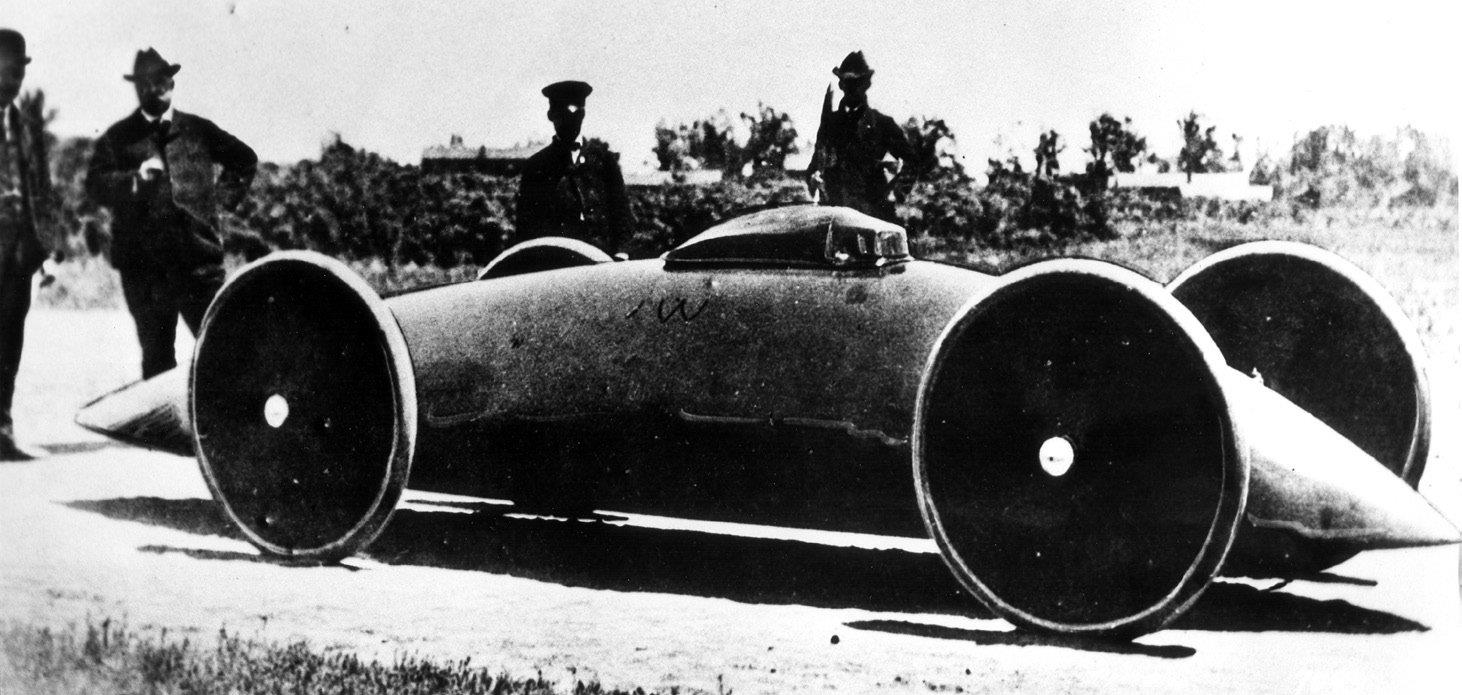
34 year old Walter C.Baker was a successful and prodigious producer of electrically driven vehicles between 1899 and 1916 and could count Thomas Edison himself, as one of his customers
27-Dec-22 historicracing.com

A typical example of a Baker is seen here with its present day owner, and knowledgeable car collector, Jay Leno, in the command position.
Like many of his rivals, Walter would be drawn towards the powerful glamour of motorsport to promote the effectiveness of his products. And with this in mind, an entry was filed for the 1902 Automobile Club of America Speed Event to be held in the remote and rural environment of South Shore Boulevard, Staten Island.

The World Land Speed Record had recently been raised to 75 mph by Frenchman Leon Serpollet with his bespoke steam-powered car, Oeuf de Paques (The Easter egg), on the seafront at Nice. But Walter was confident that his electrified imagination could do much better.
The Baker contrivance would be built around a frame of iron and wood. The driver was installed low and central, with a “flight engineer” mounted behind him. The electric motor was mounted at the back and drove the rear axle through a pair of chains and the source of the power would be forty lead-acid batteries arranged symmetrically around the dauntless crew. The whole lot would stand on four 36 inch diameter wheels fitted with 3 inch wide pneumatic tyres and the directional control of the beast would be achieved via the medium of a miniature, 7 inch, steering wheel, connected to the front-wheels via a cable and drum arrangement. Tiny windows would be provided for the comfort of the driver (the riding mechanic would be, in many ways, very much in the dark). And all this, including the wheels, would be covered in oil-cloth and given a distinctly sinister looking coat of black paint.

Walter confidently reckoned that an awesome 130 mph could be feasible. Named the Torpedo, a huge crowd would assemble to see it strut its stuff. Already excited by the appearance of Henri Fournier’s Paris-Berlin Panhard and, having earlier witnessed new mile records being set for both motorcycles and steam vehicles, the public’s expectations were running high. With the crowd pressing-in closely, Walter accelerated off down the course, which was basically a mile long straight, spiced up with a gentle curve at mid-distance.
Initially, all went very well. But that was before the Torpedo arrived at the aforementioned curve. Steering maybe a little too abruptly, perhaps due to the awkwardness of the little steering wheel, Walter caused his charge to swerve. Overcorrecting, he then set a course directly for the hospital tent! Swerving again, he started the the car swinging from side to side and rocking violently towards a point were the track was crossed by a set of metal tramlines. As the car hit the rails it bucked violently into the air, and landed heavily causing one of the rear wheels to collapse which in turn sent Walter and his crewman spinning helplessly amongst the surprised bystanders.

Their own lives were probably saved by the fact that the Baker Torpedo was the first vehicle in history to be fitted with seat-belts. But that was of little comfort to their audience. A couple of whom had now gone suspiciously quiet...
The families of the victims were distinctly unimpressed by the excitingly 20th century nature of their relatives’ demise and demanded that the authorities take action against the perpetrators. Walter and his co-pilot were arrested and the seriousness of the charges was brought home to everyone concerned, when the courts set bail at $15…EACH! Ultimately though, they were all acquitted. Despite the prosecuting council arguing that the organisers must have known that there was going to be a disaster, otherwise they wouldn’t have bothered to provide the ambulances and the hospital tent!
There’s been a lot of debate over the years concerning Walter’s speed at the time of the accident. But it seems to be generally accepted that the Baker Torpedo may have been travelling as fast as 104 mph. Walter had sufficiently good good taste though, to never try and claim any sort of a record. And it would be another two years before a speed of this magnitude was recognised officially.

The Baker Torpedo was rebuilt after its calamitous debut and made a few demonstration runs later the same year, in its home town of Cleveland, Ohio.
But there would be no more reckless attempts to get in the record books. The Baker Motor Vehicle Company are thought, to this day, to be the most prodigious producer of electric cars that the World has yet seen,building over 800 cars in 1906 alone. But eventually their combustion-engined rivals wore away at the perceived benefits of electrical motivation. And, with sales dropping, Walter Baker would bring his car construction activities to a close in 1916.
That wasn’t the last we’d hear of him though. Freed of his responsibilities, Walter joined General Electric and would rise to become the corporation’s Vice-President, before becoming getting involved in the creation of the USA’s first national television system as the founder and leader of the government sponsored, NTSC.